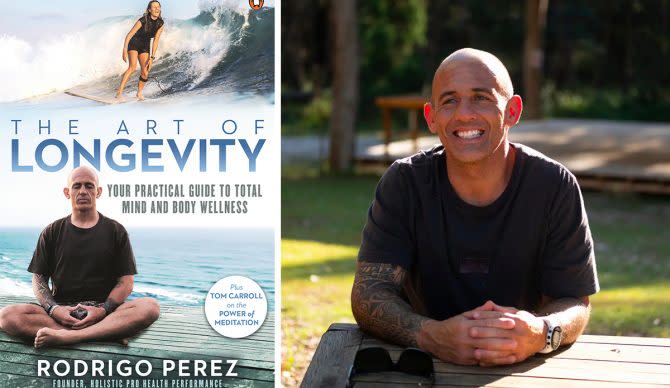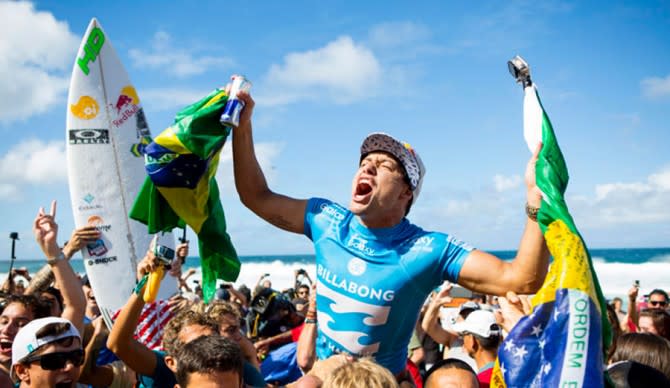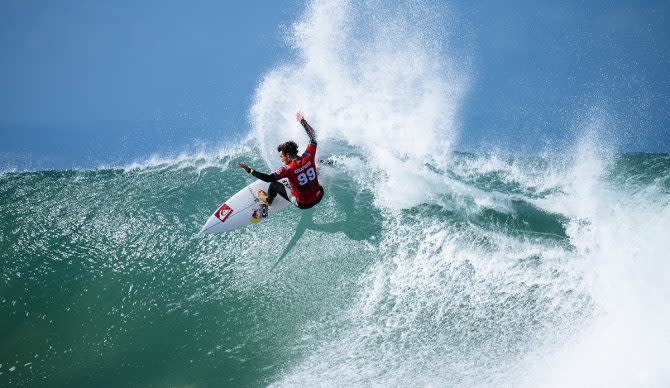Rod Perez Helps Pro Surfers Perform Better; His New Book Details His Methods

- Oops!Something went wrong.Please try again later.
- Oops!Something went wrong.Please try again later.
- Oops!Something went wrong.Please try again later.
When you have elite surfers like Jack Robinson, Tom Carroll, and Joel Parkinson vouching for your services, you’re probably doing something right. Born in Brazil and since relocated to Australia’s Gold Coast, holistic coach Rod Perez has partnered with many pro surfers over the years, including several world champions. For many, he’s their go-to trainer.
Inspired by his own tumultuous journey of personal health issues, Perez’s life path steered towards a university degree in exercise science and the realm of holistic healing. With dreams of leaving behind the concrete jungle of Sao Paulo and becoming a more dedicated surfer, he moved to Coolangatta, which is where he first crossed paths with Mick Fanning and began to train surfers. Now, with a thriving Instagram community 125,000 strong, Perez aims to expand his audience even further. He’s put his teachings – routine, mobility, strength, diet, breathing, meditation, etc. – into a book: The Art of Longevity.
As Perez’s book launches in Australia, we sat down with the performance guru to hear about what we can expect to learn from it, as well as some interesting anecdotes about how he’s helped surfers get better results.
So, why did you decide to write this book and who are you hoping to reach?
I always had the dream to write a book. Then I had a massive opportunity when people approached me who had been to a workshop with me and Tom Carroll. They said, look, we don’t have any books about your background or experience in surfing. Sometimes people can be intimidated from my program because I work with a lot of high-performance athletes, but I really want to share and help everyone. I’m not the kind of person to be close minded and not work with someone. That’s where the book idea came from – how we could develop something as a program so everyone gets the benefit, whether you’re a surfer or not.

When did your career first intertwine with professional surfers?
I used to work with a lot of triathletes and swimmers. At the time, I never thought surfing would grow as big as it did and get as professional as it is today. In 2006-2007 I started working with a couple of surfers around the Gold Coast. I was working with Mick Fanning at the time when he had an injury. Then I started to work with Adriano De Souza for a couple years and it grew from there. I live in the “Mecca” of surfing, Coolangatta, Australia, where there are so many surfers. In Brazil when you are a kid you get a soccer ball as a present. In Australia you get a surfboard. Living close to the Superbank helped me to open more growth and even improve my surfing as well.
What about your approach is specific to surfers?
I love good precision, which comes from movement – how we connect the body, how your lower body connects with your upper body, how your core can deliver energy from all the links around for rotation, for the bottom turn. You have to understand how your eyes, your head, and your hands move. So with my methodology I tried to look into precision: What we can improve from the pop-up to going down the line and having awareness in the body to do a bottom turn and nice top turn. When we talk about beginners, they all have this squat stance, they’re very tired, they don’t move their knees, they don’t move their hips. When we talk about more intermediate to advanced, it’s about creating more mobility, more range of motion, getting strong in areas where you apply more force, where they can be more precise and not make mistakes. It’s all centered around movement, getting more mobile, more flexible, moving the fascia of the body in the right directions when needed, and also getting strong.
I think a lot of people give too much strength training to surfers. Yes, surfers do need strength: good pulls, good push, good squat, good deadlifts. But that is only 15-20 percent of the training that a good surfer needs because there are so many broken patterns with surfers. They cannot move their hips properly, or they can’t truly lift their arms up because of tight shoulders, or their backs are too tight with lower back pain, tight ankles, things like that. For example, I worked with Ricardo Christie. He is the kind of person that didn’t need that much strength, but he needed a lot of body flow movement to improve. Jack Freestone was similar.
Lately I’ve been working a lot with Joel Parkinson and some older guys, trying to keep them in shape, moving well, and ripping. Joel has been with me for nearly a year and he has changed so much. He lost a lot of weight. His injuries are gone. He’s surfing really high performance.
What do you tell a surfer who’s thinking about working with you? How do you convince them that your program is something they need?
My pitch is: How many mistakes are you making on the board? How many times did you fall? How much stability do you need to be stable on the board? Does your body respond when you need to? If it doesn’t respond, we need to connect. How is your core strength? Can you synchronize the movements when you want? When you land from a floater, can you stay on top of the board? If you are an intermediate to advanced surfer, how many injuries have you had from surfing? How’s your lower back? How are your knees? Your hips? Are you moving well on your backhand to do a nice top turn?

Can you highlight one or two examples of surfers that you’ve worked with and how you’re able to measurably enhance their performance?
One big one who I worked with for a couple of years, and always knew that he would be in the top five someday, is Griffin Colapinto. It was good to see how much he understood about putting his routine together, building new habits, understanding his mindset, and his core connection. He hasn’t had as many injuries.
I also have the pleasure to work with Erin Brooks every year when she comes to Australia. I see how she is changing and whenever she comes to the Gold Coast we always focus on her backhand and how the core should be connected and stable to apply the movements that she needs. And to be precise. Erin just won Snapper Rocks and all the training we did made sure that the whole body activates, the whole body is stable.
Who has been your favorite surfer to work with and who would be your dream pro to work with?
I would like to work with Italo. I think I could make a massive difference for him as far as understanding body connection. He’s an amazing surfer. I’d love to work with John John. I love the way he carves, the way he flows. It’s so beautiful. I’d also be happy to work with Caity Simmers. She’s precise and you can see it in her eyes that she is hungry. I like that.
As far as a surfer that I’ve worked with before, I worked with Gabriel Medina for a few years. He was always a good inspiration. He used to call me three to four weeks before the contest to spend time with me. Now he has his own team back in Brazil, but I am always here to give support to him if he needs it.
For surfers who want to make a change but find it overwhelming, what’s a good way to start?
First, you have to understand who you are. Second, you need to accept who you are. Third, put your ego down, be open minded, and be open to learning new things. If you are not open to learning new things and listening to people who want to help you, it will be hard to progress. But I understand them. There are so many people throwing their opinions out there, telling you to change this, change that. It’s hard. But if you really want to work with me, I would say give it 10 weeks or so to program change, maybe six months. And just believe in doing the work. If you don’t put in work you will never see the difference. It can be overwhelming to change things, but that’s part of the process. It’s scary to change the things you’ve been doing and move onto new things. That’s the hard part for human beings, but that’s when we grow and step up into our game.
What’s the most important piece of advice that you’ve received that you pass on to your students?
Commitment and doing the work. Simple. If you don’t do it, no one’s going to do it for you. It’s about putting in the time and making it happen. If you want to improve your surfing, you need to paddle more and be in the water more. If you want to make your body change to improve your surfing, you need to put the time into your routine.
The post Rod Perez Helps Pro Surfers Perform Better; His New Book Details His Methods first appeared on The Inertia.

